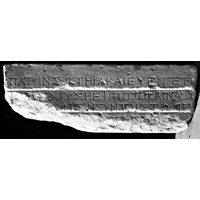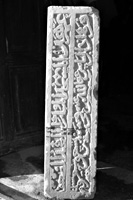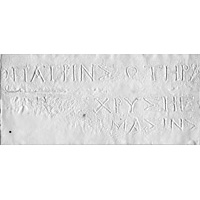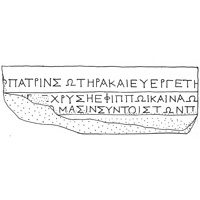MAMA XI 1 (Apollonia) 
Honorific inscription on architrave concerning statues and cult
- Type of monument:
- Honorific inscription.
- Location:
- Uluborlu (Apollonia): in the İsmet Paşa Okulu, said to have been brought from a mosque in the citadel. Now (2012) in Uluborlu museum.
- Description:
- White marble architrave, no upper moulding, plain behind, the front divided into three fascias, all originally inscribed. On the upper surface, a two-line Arabic inscription. Complete at top, broken below at left, neatly recut to left and right.
- Dimensions:
- Ht. 0.30; W. 0.89; Th. 0.24; letters 0.032-0.040 (line 1), 0.025-0.032 (lines 2-3).
- Record:
- Squeeze; line drawing; MB notebook copy; photograph (1956/87).
- Publication:
- Labarre, Özsait, Özsait and Güceren 2012: 127, no.6.
- Date:
- First century BC.
[ὁ δῆμος ἐτίμησεν - - - φιλ]ό̣πατριν σωτῆρα καὶ εὐεργέτη̣[ν - - - - - - - - - - - - - -]
[- - - - - - - - - - εἰκόνι ἐπὶ στυλ]ί̣δ̣ο̣ς̣ χρυσῇ ἐφίππωι καὶ ναῷ[- - - - - - - - - - - - - -]
[- - - - - - - - - - - - - - - - - - ἀγά]λ̣μασιν σὺν τοῖς τῶν π[ρογόνων (e.g.) ἀνδριᾶσιν]
[- - - - - - - - - - - - - - - - - - - - - - - - - - - - - -]
[The demos honoured... lover of his homeland, saviour and benefactor... with a gilt equestrian [statue on a columnar base] and a temple... [and with sacral sta]tues, along with the [statues] of his a[ncestors ...]







This monument (published without restorations or commentary by Labarre, Özsait, Özsait and Güceren 2012: 127, no.6) is an honorific inscription for a civic benefactor. The honours which he is voted in the surviving part of the text (a gilt equestrian statue, other statues, and a naos) suggest a date in the first century BC; see further below. The original physical form of the monument is uncertain. At the start of line 1, we need to restore a formula such as [ὁ δῆμος ἐτίμησεν], followed by the name and patronym of the honorand: for this structure, compare the late Hellenistic honorific inscription for Polystratos at Apameia (Drew-Bear and Fillon 2011), ὁ δῆμος ἐτ[ίμησεν] Πολύ[σ]τρατον Τιμοθέο[υ ἄν]δρα καλὸν καὶ ἀγαθόν, γυμνασίαρ[χον - - ἐ]παινῶι, χρυσῶι στεφάνωι, κτλ. This being the case, the original monument must have been well over twice the breadth of the surviving stone (i.e. at least 2m wide). It is conceivable that the inscription was situated on the architrave of the naos mentioned in line 2.
In line 1, the honorific term φιλόπατρις is largely confined to the Roman imperial period (Robert, OMS VI 262-3; Hellenica XIII, 215; Drew-Bear 1978: 74; Herrmann 1994: 208; Ferrary 2001: 806; for its use at Apollonia, cf. MAMA IV 163), although examples are known from the mid-first century BC (e.g. Sardis VII 1, 27.6).
In line 2, the individual concerned is honoured with a gilt equestrian statue ([εἰκόνι]... χρυσῇ ἐφίππωι). The statue presumably stood on a marble base of some kind, and the restoration [εἰκόνι ἐπὶ στυλ]ί̣δ̣ο̣ς̣ would fit the traces at the beginning of the line (although the word order is odd). Similar phrases are found in the Claros decree in honour of Polemaios of Kolophon (SEG 39, 1243, col. V 43-4: στῆσαι δὲ καὶ εἰκόνα χρυσῆν ἐπὶ στυλίδος), in one of the Kyme decrees for Archippe (IKyme 13, col. VI 29-30: στῆσαι δὲ τὴν εἰκόνα τὴν χρυσῆν ἐπὶ στυλίδος μαρμαρίνης), in a Pergamene decree honouring Attalos III (OGIS 332.9-10: στῆσαι δὲ αὐτοῦ καὶ εἰκόνα χρυσῆν ἔφιππον ἐπὶ στυλίδος μαρμαρίνης), and in the first Pergamene decree in honour of Diodoros Pasparas (IGR IV 292; ISE III 190), in which Diodoros is honoured with two gilt statues, two bronze statues, and one marble statue, τῶν μὲν χρ[υσῶν ἐπὶ στυ]λίδων μαρμαρίνων, τῶν δὲ χαλκῶν ἐπὶ βημάτων ὁμοίως μαρμαρίνων (lines 27-8). See further Robert and Robert 1989: 59-60; Drew-Bear and Fillon 2011.
The word [ἀγά]λ̣μασιν at the start of line 3 presumably refers to a number of other statues set up for the honorand ([καὶ ἄλλοις x μαρμαρίνοις ἀγά]λ̣μασιν, vel sim.). Compare the list of statues set up for Iollas at Sardis in the mid-first century BC (Sardis VII 1, 27.1-6): ὁ δῆμος ἐτίμησεν Ἰόλλαν... ἰκόνι χρυσῇ καὶ ἄλλῃ χρυσῇ κολοσσικῇ καὶ ἄλλῃ χρυσῇ ἐφίππῳ καὶ ἄλλαις χαλκαῖς δ΄ καὶ ἀγάλμασιν μαρμαρίνοις τρισὶν καὶ ἄλλαις γραπταῖς δ΄. If I have restored the phrase at the end of line 3 correctly, the text would be indicating that these statues were to be set up ‘alongside the statues of his ancestors’: compare perhaps Wilhelm 1911: 54-61 (Synnada), where a posthumous statue of the deceased Philonides appears to be erected alongside a statue of a notable ancestor. For the use of the preposition σύν in this context, cf. the Chian decree in honour of L. Nessius (IGR IV 1703, mid-first century BC), in which the demos has voted Nessius a statue in the agora, but the honorand himself would prefer it to be erected ‘along with the statues of his sons’ (lines 9-12: ἐπεὶ π̣ροεψηφίσατο ὁ δῆμος ἀνδριάντος ἀνάστασιν αὐτῷ ἐν τῷ ἐπισημοτάτῳ τῆς ἀγ[ο]ρ̣ᾶς τόπῳ, βούλεται δὲ αὐτὸν συναναστῆσαι τοῖς τῶν τέκνων ἀνδριᾶσιν ἐπὶ τῶν στυλείδων, δεδόχθαι ἐπικεχωρῆσθαι αὐτῶι).
At the end of line 2, it is stated that the honorand is also to receive a temple (ναῷ) in his honour. Our anonymous honorand therefore seems to have been one of a small number of civic benefactors of the first century BC to receive lifetime cult honours on the model of the civic cults of Hellenistic monarchs (Price 1984: 47-51; Gauthier 1985: 59-63; Strubbe 2004). So in the first Pergamene decree in honour of Diodoros Pasparas (IGR IV 292; ISE III 190), Diodoros is honoured during his lifetime with a precinct and temple at Pergamon (lines 40-2: ἀνεῖναι δ[ὲ] αὐτοῦ κ[αὶ τ]έμενος ἐν Φιλεταιρείαι, ὀνομάσαντας Διοδώρειον, ἐν ὧι κατασκευασθ[ῆναι] ναὸν λί[θου] λευκοῦ, εἰς ὃν ἀνατεθῆναι τὸ ἄγαλμα); see also I.Knidos 59 (Augustan period: timai isotheoi, including an altar, sacrifices, a procession, and an athletic contest, for the local benefactor Artemidoros). The agalmata depicting the honorand in line 3 need not necessarily have been cult statues; the term agalma refers primarily to the sacred context of the image (in or near a sanctuary) rather than its function as an object of cult (Price 1984: 176-9).
The honorand is likely to have been a member of the most prominent family at Apollonia in the late Republican and early Imperial period, that of Artemon son of Olympichos and his descendants. Artemon son of Olympichos is attested as priest of Zeus at Apollonia, probably in the mid-first century BC (MAMA IV 141). His floruit can be inferred from the career of his grandson, Apollonios son of Olympichos, who was honoured at Apollonia for (among other benefactions) having undertaken an embassy to Germanicus, most likely in AD 18 (MAMA IV 142). Several other monuments of the late first century BC and early first century AD mention members of the family (MAMA IV 160, 171, 172; IGR III 320). At some point after AD 18, the family seems to have received the Roman citizenship; two inscriptions, probably of the mid-first century AD, record public honours for C. Iulius Cornelia Olympichos (MAMA IV 161) and his son M. Iulius Longus (MAMA IV 162). The dominance of this family in the late Republican and early Imperial public epigraphy of Apollonia renders it very likely that the honorand of our monument was among their number.
I take the opportunity to note a few corrections to the text of MAMA IV 161, honours for C. Iulius Cornelia Olympichos. The text in MAMA IV reads as follows:
[ὁ δὴμος ἐτείμησεν | Γάϊον Ἰούλιον Ὀλυμπίχου (?) υἱὸν | Κορ]ν̣η̣λί̣α̣ Ὀλύμπιχον φιλο[σέβασ|το]ν̣ ἐπί τε τῆι εἰς τοὺς Σεβα[στοὺς | ε]ὐσεβείαι καὶ ταῖς δημ̣[ωφελέ|σιν] αὐτοῦ ἀπὸ προγόν[ων καὶ | (5) τοῦ] πατρὸς εἰς τὴν [συνπα|ράσ]τ̣ασιν εὐεργεσι[ῶν πολ|λῶν φ]ιλοδοξίαις.
The restoration of the patronym Ὀλυμπίχου is unwarranted, and the phraseology in lines 3-7 unparalleled. Read instead:
[ὁ δὴμος ἐτείμησεν | Γάϊον Ἰούλιον - - υἱὸν | Κορ]ν̣η̣λί̣α̣ Ὀλύμπιχον φιλο[σέβασ|το]ν̣ ἐπί τε τῆι εἰς τοὺς Σεβα[στοὺς | ε]ὐσεβείαι καὶ ταῖς δι̣η̣[νεκέ|σιν] αὐτοῦ ἀπὸ προγόν[ων καὶ | (5) τοῦ] πατρὸς εἰς τὴν [πόλιν | ἐν] π̣ᾶσιν εὐεργεσί[αις τε | καὶ φ]ιλοδοξίαις.